Yale Song
PerceptionLM: Open-Access Data and Models for Detailed Visual Understanding
Apr 17, 2025



Abstract:Vision-language models are integral to computer vision research, yet many high-performing models remain closed-source, obscuring their data, design and training recipe. The research community has responded by using distillation from black-box models to label training data, achieving strong benchmark results, at the cost of measurable scientific progress. However, without knowing the details of the teacher model and its data sources, scientific progress remains difficult to measure. In this paper, we study building a Perception Language Model (PLM) in a fully open and reproducible framework for transparent research in image and video understanding. We analyze standard training pipelines without distillation from proprietary models and explore large-scale synthetic data to identify critical data gaps, particularly in detailed video understanding. To bridge these gaps, we release 2.8M human-labeled instances of fine-grained video question-answer pairs and spatio-temporally grounded video captions. Additionally, we introduce PLM-VideoBench, a suite for evaluating challenging video understanding tasks focusing on the ability to reason about "what", "where", "when", and "how" of a video. We make our work fully reproducible by providing data, training recipes, code & models.
VITED: Video Temporal Evidence Distillation
Mar 17, 2025Abstract:We investigate complex video question answering via chain-of-evidence reasoning -- identifying sequences of temporal spans from multiple relevant parts of the video, together with visual evidence within them. Existing models struggle with multi-step reasoning as they uniformly sample a fixed number of frames, which can miss critical evidence distributed nonuniformly throughout the video. Moreover, they lack the ability to temporally localize such evidence in the broader context of the full video, which is required for answering complex questions. We propose a framework to enhance existing VideoQA datasets with evidence reasoning chains, automatically constructed by searching for optimal intervals of interest in the video with supporting evidence, that maximizes the likelihood of answering a given question. We train our model (VITED) to generate these evidence chains directly, enabling it to both localize evidence windows as well as perform multi-step reasoning across them in long-form video content. We show the value of our evidence-distilled models on a suite of long video QA benchmarks where we outperform state-of-the-art approaches that lack evidence reasoning capabilities.
Ego-Exo4D: Understanding Skilled Human Activity from First- and Third-Person Perspectives
Nov 30, 2023



Abstract:We present Ego-Exo4D, a diverse, large-scale multimodal multiview video dataset and benchmark challenge. Ego-Exo4D centers around simultaneously-captured egocentric and exocentric video of skilled human activities (e.g., sports, music, dance, bike repair). More than 800 participants from 13 cities worldwide performed these activities in 131 different natural scene contexts, yielding long-form captures from 1 to 42 minutes each and 1,422 hours of video combined. The multimodal nature of the dataset is unprecedented: the video is accompanied by multichannel audio, eye gaze, 3D point clouds, camera poses, IMU, and multiple paired language descriptions -- including a novel "expert commentary" done by coaches and teachers and tailored to the skilled-activity domain. To push the frontier of first-person video understanding of skilled human activity, we also present a suite of benchmark tasks and their annotations, including fine-grained activity understanding, proficiency estimation, cross-view translation, and 3D hand/body pose. All resources will be open sourced to fuel new research in the community.
EgoVLPv2: Egocentric Video-Language Pre-training with Fusion in the Backbone
Jul 11, 2023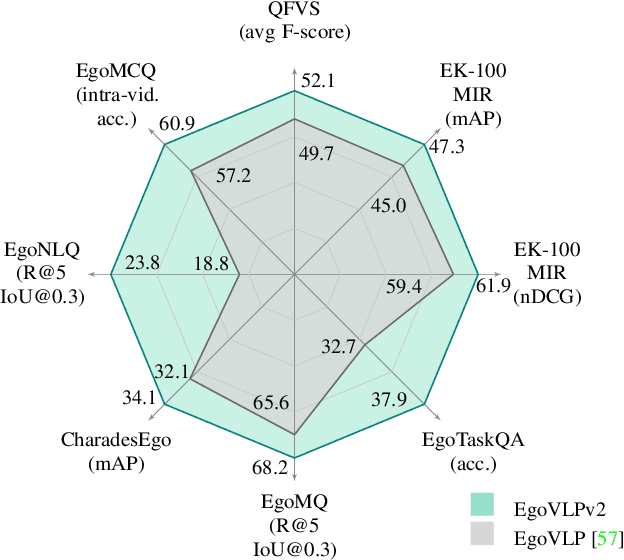
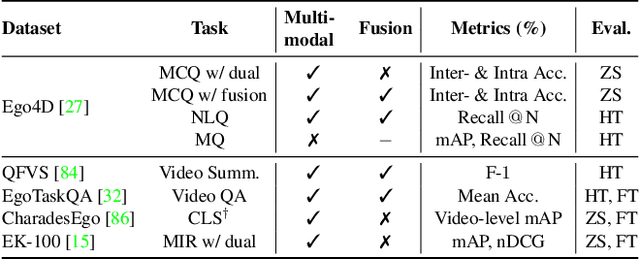

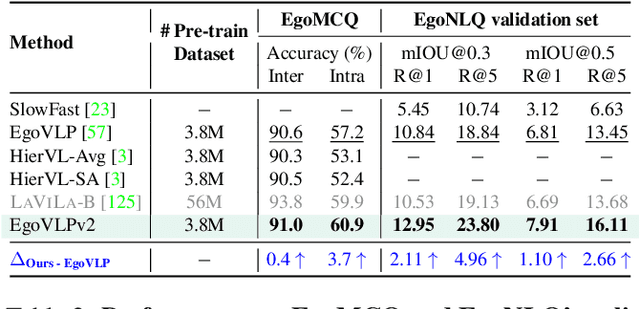
Abstract:Video-language pre-training (VLP) has become increasingly important due to its ability to generalize to various vision and language tasks. However, existing egocentric VLP frameworks utilize separate video and language encoders and learn task-specific cross-modal information only during fine-tuning, limiting the development of a unified system. In this work, we introduce the second generation of egocentric video-language pre-training (EgoVLPv2), a significant improvement from the previous generation, by incorporating cross-modal fusion directly into the video and language backbones. EgoVLPv2 learns strong video-text representation during pre-training and reuses the cross-modal attention modules to support different downstream tasks in a flexible and efficient manner, reducing fine-tuning costs. Moreover, our proposed fusion in the backbone strategy is more lightweight and compute-efficient than stacking additional fusion-specific layers. Extensive experiments on a wide range of VL tasks demonstrate the effectiveness of EgoVLPv2 by achieving consistent state-of-the-art performance over strong baselines across all downstream. Our project page can be found at https://shramanpramanick.github.io/EgoVLPv2/.
Egocentric Video Task Translation @ Ego4D Challenge 2022
Feb 03, 2023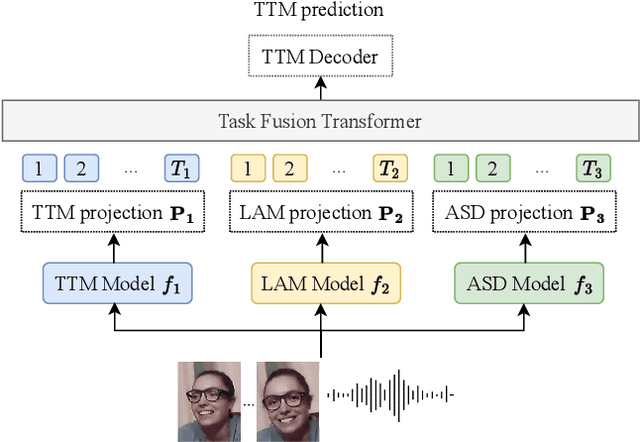

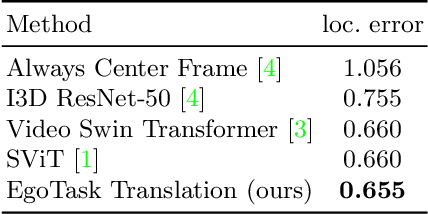
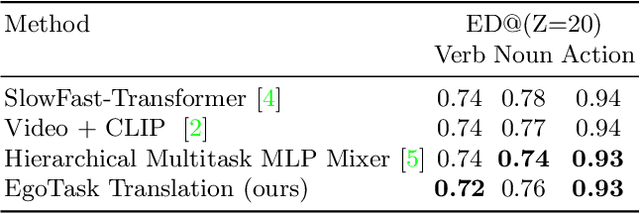
Abstract:This technical report describes the EgoTask Translation approach that explores relations among a set of egocentric video tasks in the Ego4D challenge. To improve the primary task of interest, we propose to leverage existing models developed for other related tasks and design a task translator that learns to ''translate'' auxiliary task features to the primary task. With no modification to the baseline architectures, our proposed approach achieves competitive performance on two Ego4D challenges, ranking the 1st in the talking to me challenge and the 3rd in the PNR keyframe localization challenge.
Egocentric Video Task Translation
Dec 13, 2022Abstract:Different video understanding tasks are typically treated in isolation, and even with distinct types of curated data (e.g., classifying sports in one dataset, tracking animals in another). However, in wearable cameras, the immersive egocentric perspective of a person engaging with the world around them presents an interconnected web of video understanding tasks -- hand-object manipulations, navigation in the space, or human-human interactions -- that unfold continuously, driven by the person's goals. We argue that this calls for a much more unified approach. We propose EgoTask Translation (EgoT2), which takes a collection of models optimized on separate tasks and learns to translate their outputs for improved performance on any or all of them at once. Unlike traditional transfer or multi-task learning, EgoT2's flipped design entails separate task-specific backbones and a task translator shared across all tasks, which captures synergies between even heterogeneous tasks and mitigates task competition. Demonstrating our model on a wide array of video tasks from Ego4D, we show its advantages over existing transfer paradigms and achieve top-ranked results on four of the Ego4D 2022 benchmark challenges.
Neural-Sim: Learning to Generate Training Data with NeRF
Jul 22, 2022



Abstract:Training computer vision models usually requires collecting and labeling vast amounts of imagery under a diverse set of scene configurations and properties. This process is incredibly time-consuming, and it is challenging to ensure that the captured data distribution maps well to the target domain of an application scenario. Recently, synthetic data has emerged as a way to address both of these issues. However, existing approaches either require human experts to manually tune each scene property or use automatic methods that provide little to no control; this requires rendering large amounts of random data variations, which is slow and is often suboptimal for the target domain. We present the first fully differentiable synthetic data pipeline that uses Neural Radiance Fields (NeRFs) in a closed-loop with a target application's loss function. Our approach generates data on-demand, with no human labor, to maximize accuracy for a target task. We illustrate the effectiveness of our method on synthetic and real-world object detection tasks. We also introduce a new "YCB-in-the-Wild" dataset and benchmark that provides a test scenario for object detection with varied poses in real-world environments.
Scaling Novel Object Detection with Weakly Supervised Detection Transformers
Jul 11, 2022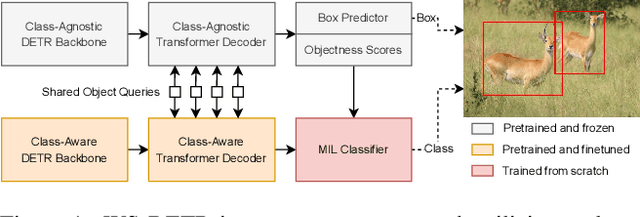

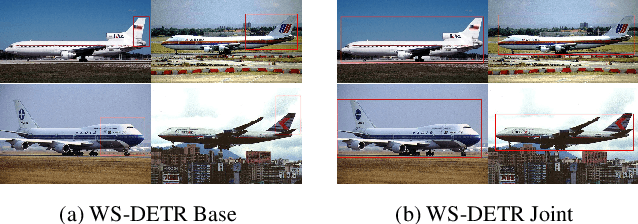
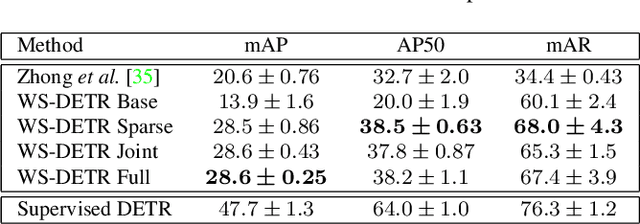
Abstract:Weakly supervised object detection (WSOD) enables object detectors to be trained using image-level class labels. However, the practical application of current WSOD models is limited, as they operate at small scales and require extensive training and refinement. We propose the Weakly Supervised Detection Transformer, which enables efficient knowledge transfer from a large-scale pretraining dataset to WSOD finetuning on hundreds of novel objects. We leverage pretrained knowledge to improve the multiple instance learning framework used in WSOD, and experiments show our approach outperforms the state-of-the-art on datasets with twice the novel classes than previously shown.
Visual Attention Emerges from Recurrent Sparse Reconstruction
Apr 23, 2022
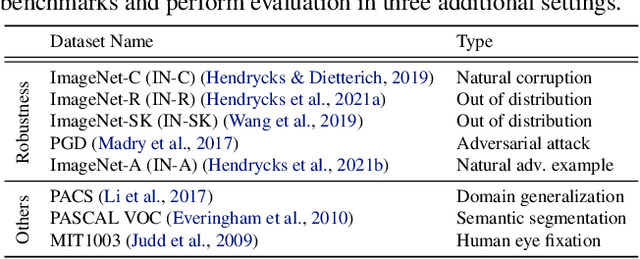
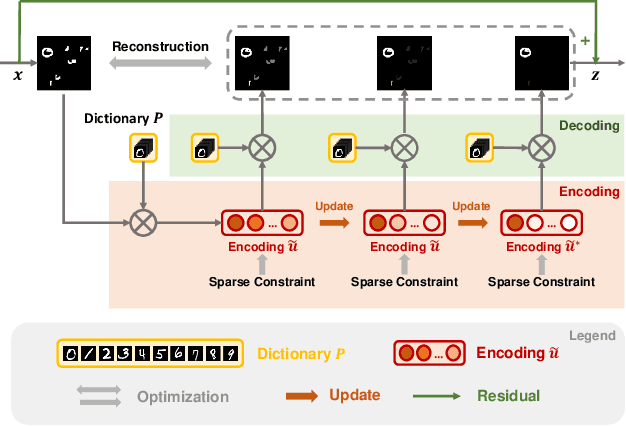
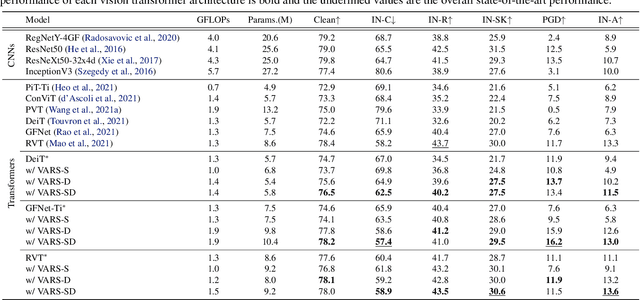
Abstract:Visual attention helps achieve robust perception under noise, corruption, and distribution shifts in human vision, which are areas where modern neural networks still fall short. We present VARS, Visual Attention from Recurrent Sparse reconstruction, a new attention formulation built on two prominent features of the human visual attention mechanism: recurrency and sparsity. Related features are grouped together via recurrent connections between neurons, with salient objects emerging via sparse regularization. VARS adopts an attractor network with recurrent connections that converges toward a stable pattern over time. Network layers are represented as ordinary differential equations (ODEs), formulating attention as a recurrent attractor network that equivalently optimizes the sparse reconstruction of input using a dictionary of "templates" encoding underlying patterns of data. We show that self-attention is a special case of VARS with a single-step optimization and no sparsity constraint. VARS can be readily used as a replacement for self-attention in popular vision transformers, consistently improving their robustness across various benchmarks. Code is released on GitHub (https://github.com/bfshi/VARS).
One Network Doesn't Rule Them All: Moving Beyond Handcrafted Architectures in Self-Supervised Learning
Mar 15, 2022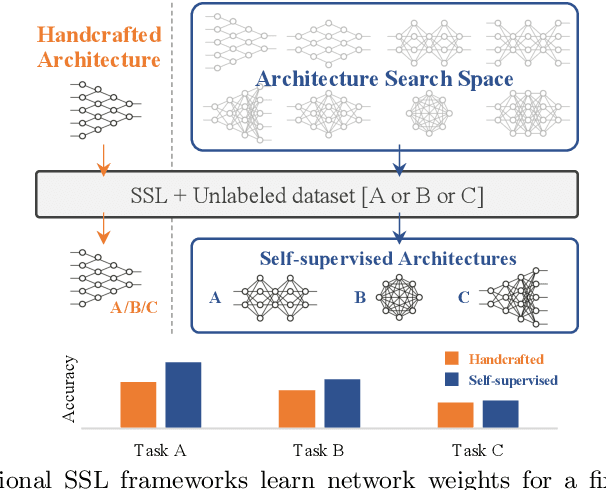
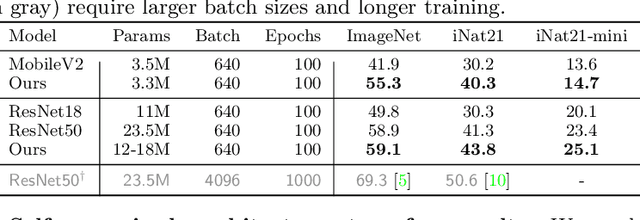

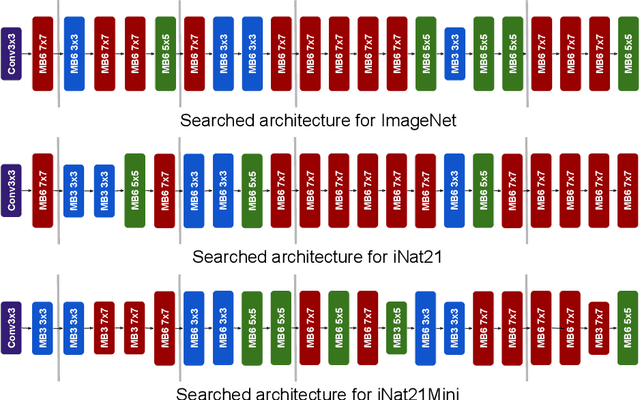
Abstract:The current literature on self-supervised learning (SSL) focuses on developing learning objectives to train neural networks more effectively on unlabeled data. The typical development process involves taking well-established architectures, e.g., ResNet demonstrated on ImageNet, and using them to evaluate newly developed objectives on downstream scenarios. While convenient, this does not take into account the role of architectures which has been shown to be crucial in the supervised learning literature. In this work, we establish extensive empirical evidence showing that a network architecture plays a significant role in SSL. We conduct a large-scale study with over 100 variants of ResNet and MobileNet architectures and evaluate them across 11 downstream scenarios in the SSL setting. We show that there is no one network that performs consistently well across the scenarios. Based on this, we propose to learn not only network weights but also architecture topologies in the SSL regime. We show that "self-supervised architectures" outperform popular handcrafted architectures (ResNet18 and MobileNetV2) while performing competitively with the larger and computationally heavy ResNet50 on major image classification benchmarks (ImageNet-1K, iNat2021, and more). Our results suggest that it is time to consider moving beyond handcrafted architectures in SSL and start thinking about incorporating architecture search into self-supervised learning objectives.
 Add to Chrome
Add to Chrome Add to Firefox
Add to Firefox Add to Edge
Add to Edge